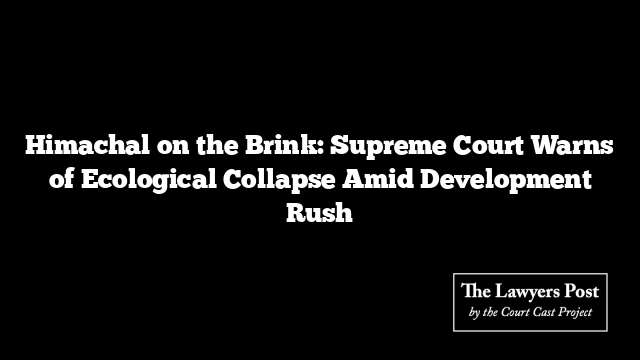In a thunderclap of judicial warning, the Supreme Court has raised the red flag over Himachal Pradesh’s unrelenting march of development, cautioning that if the current trajectory continues, the entire hill state may someday “vanish into thin air from the map of the country.”
The stark observation came as the Court paused a Himachal Pradesh High Court order related to a local administrative matter—but quickly pivoted to the bigger picture: the crumbling ecological spine of the fragile Himalayan state.
The bench, comprising Justices JB Pardiwala and R Mahadevan, was unequivocal in tone: “Revenue cannot come at the cost of rivers, forests, and mountain slopes. The earth is not a vending machine.”
At the center of the hearing was a case filed by Pristine Hotels and Resorts Pvt. Ltd., challenging the state’s denial of permission to build on Shri Tara Mata Hill—an area recently notified as a “Green Zone,” effectively banning private construction. While the Supreme Court upheld the state’s decision, it issued a broader call to arms: protect now, or mourn later.
The judges pointed to the scars left by recent disasters—flash floods and cloudbursts in Kullu and Manali—tracing them directly to unchecked tree felling, soil erosion, and thoughtless building. “We’ve seen forests disappear. Rivers choked. Hills gouged. And in return, we’ve invited calamity,” the Court noted.
It didn’t stop there.
The Court blasted the gutting of forest guard posts—checkpoints once positioned as sentinels of the state’s greenery. Their removal, the Court said, had given illegal timber operations a free run across districts, leaving the mountains stripped bare.
On infrastructure, the message was equally unforgiving: “Four-lane dreams are turning into four-alarm disasters,” the Court said, highlighting how highways, tunnels, and ropeways often rip through hillsides without scientific planning or environmental accountability. Monsoons, especially those in 2023 and 2025, have only amplified the destruction.
And then, tourism.
While acknowledging its economic lifeline, the Court minced no words about its downsides. From garbage-choked hill towns to water-starved valleys, the surge in visitors during peak seasons has overwhelmed an already fragile setup. Mountains of waste, often dumped or burned due to poor logistics, have become the new peaks of the state.
“Tourism is booming, but so is the trash,” the Court observed. The Waste Management Rules of 2016, it noted, are not just outdated but largely unenforced. With garbage trucks unable to scale steep terrain, and local rules trailing far behind environmental needs, the state is drowning in its own negligence.
The Court also painted a bleak picture of unregulated construction. Hotels and homestays—erected on unstable slopes to cash in on the tourist boom—have popped up like mushrooms after a landslide, many without proper clearance or safety checks. “Employment generation is no justification for ecological suicide,” the judges said.
The message was blunt, urgent, and deeply sobering.
The Supreme Court has now converted the appeal into a full-blown Public Interest Litigation, instructing the Himachal Pradesh government to report back on steps taken to address the crisis—ecological, administrative, and legislative—by August 25.
“Much damage is already done,” the Court said. “But something is better than nothing. And doing nothing is no longer an option.”





